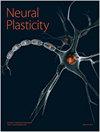Electroacupuncture Therapy Effectively Protects the Rat Brain after Intracerebral Hemorrhage
IF 3.7
4区 医学
Q2 Medicine
引用次数: 0
Abstract
Objective. Electroacupuncture (Ea) is a useful complementary and alternative therapy for intracerebral hemorrhage (ICH). However, the neurobiological basis for the Ea treatment of ICH is still unclear. The primary aim of the present study was to explore whether Ea prevents brain edema, apoptosis, excitotoxicity, and neuroinflammation in rats after hemorrhagic stroke. Methods. Rats were randomly divided into Sham, Control, and Ea groups. We used modified neurological severity score (mNSS) and gait analysis to estimate neurological function in rats, and PET/CT to assess glucose uptake and the hemorrhagic focus volume. Measurement of the brain water content and TUNEL staining were used to evaluate brain edema and cell apoptosis, respectively. The serum myelin basic protein (MBP), neuron-specific enolase (NSE), calcium-binding protein B (S100B), and tumor necrosis factor-α (TNF-α) concentrations were examined with ELISA. The expression levels of the CD68, GALC, Arg-1, iNOS, NR2A, Glu2R, AQP4, MAP2, GFAP, AQP9, Bcl-2, Bax, and Glu proteins around the hematoma were detected via immunohistochemistry staining. Western blot was used to analyze the levels of the AQP4, AQP9, Bax, Bcl-2, iNOS, and Arg-1 proteins. Results. Ea treatment improved neurological function and reduced the hemorrhagic area and brain water content in rats after ICH. The serum concentrations of MBP, NSE, S100B, and TNF-α all decreased significantly in the Ea group compared with the Control group. Expression levels of the Glu, NR2A, AQP4, AQP9, Bax, GFAP, iNOS, and CD68 proteins in brain tissue surrounding the hematoma were obviously suppressed in ICH rats following Ea treatment. Moreover, Ea stimulation increased the levels of the MAP2, GALC, Glu2R, Arg-1, and Bcl-2 proteins, but reduced the number of TUNEL-positive cells in rats after ICH. Conclusion. The results of this study suggest that Ea may exert neuroprotective effects by suppressing brain edema, apoptosis, excitotoxicity, and neuroinflammation.电针疗法能有效保护脑出血后的大鼠大脑
目的。电针(Ea)是治疗脑出血(ICH)的一种有效的补充和替代疗法。然而,电针治疗 ICH 的神经生物学基础仍不清楚。本研究的主要目的是探讨 Ea 是否能预防出血性中风后大鼠的脑水肿、细胞凋亡、兴奋毒性和神经炎症。研究方法将大鼠随机分为 Sham 组、对照组和 Ea 组。我们使用改良神经严重程度评分(mNSS)和步态分析来评估大鼠的神经功能,并使用 PET/CT 评估葡萄糖摄取量和出血灶体积。脑含水量测量和 TUNEL 染色分别用于评估脑水肿和细胞凋亡。用 ELISA 检测血清髓鞘碱性蛋白(MBP)、神经元特异性烯醇化酶(NSE)、钙结合蛋白 B(S100B)和肿瘤坏死因子-α(TNF-α)的浓度。通过免疫组化染色检测血肿周围 CD68、GALC、Arg-1、iNOS、NR2A、Glu2R、AQP4、MAP2、GFAP、AQP9、Bcl-2、Bax 和 Glu 蛋白的表达水平。利用 Western 印迹分析 AQP4、AQP9、Bax、Bcl-2、iNOS 和 Arg-1 蛋白的水平。结果Ea 治疗改善了 ICH 大鼠的神经功能,减少了出血面积和脑水含量。与对照组相比,Ea 组大鼠血清中 MBP、NSE、S100B 和 TNF-α 的浓度均显著下降。Ea 治疗后,ICH 大鼠血肿周围脑组织中 Glu、NR2A、AQP4、AQP9、Bax、GFAP、iNOS 和 CD68 蛋白的表达水平明显下降。此外,Ea 刺激可提高 ICH 大鼠体内 MAP2、GALC、Glu2R、Arg-1 和 Bcl-2 蛋白的水平,但会减少 TUNEL 阳性细胞的数量。结论本研究结果表明,Ea 可通过抑制脑水肿、细胞凋亡、兴奋毒性和神经炎症发挥神经保护作用。
本文章由计算机程序翻译,如有差异,请以英文原文为准。
求助全文
约1分钟内获得全文
求助全文
来源期刊

Neural Plasticity
Neuroscience-Neurology
CiteScore
5.70
自引率
0.00%
发文量
0
审稿时长
1 months
期刊介绍:
Neural Plasticity is an international, interdisciplinary journal dedicated to the publication of articles related to all aspects of neural plasticity, with special emphasis on its functional significance as reflected in behavior and in psychopathology. Neural Plasticity publishes research and review articles from the entire range of relevant disciplines, including basic neuroscience, behavioral neuroscience, cognitive neuroscience, biological psychology, and biological psychiatry.
 求助内容:
求助内容: 应助结果提醒方式:
应助结果提醒方式:


